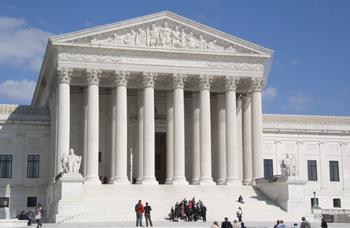Federal Law: 2011 SC Justices
 What is Federal Law?
What is Federal Law?
Federal Law is classified as the legal spectrum – in addition to any or all pertinent legislature – involving the Federal Government; the legal scope of Federal Law not only includes the regulation of governmental legislature, but also the proposition – and subsequent passing – of legislature.
Federal Law within the United States of America
Within the organizational structure of the United States, 3 branches of government exist in concert; the importance of 3 different governmental branches in lieu of a single governmental body was expressed within the Constitution of the United States. The Constitution is a legislative document that is considered to be the primary authority in Federal Law illustrating, conveying, and classifyingprecepts, laws, legality, and procedure with regard to both the citizens and the government of the United States of America. Within the Constitution, the authors expressed a desire to separate the governmental power structure in order to prevent a concentration of power within a single governing body; as a result, the oversight of Federal Law was distributed between the 3 branches of the United States Government – the Legislative Branch, the Executive Branch, and the Judicial Branch.
Federal Law vs. Administrative Law
While the responsibility and jurisdiction pertaining to both Administrative Law and Federal Law differ, their respective operation – as well as their symbiotic operation – results in the lawful establishment, regulation, and upkeep of United States Governmental Law; the jurisdiction of Federal Law and Administrative Law are disbursed as follows:
1. The Judicial Branch is comprised of the United States Supreme Court, which oversees judicial proceedings on a Federal level with regard to the maintenance of Federal Law; the Supreme Court upholds and enforces all legality passed by the legislative branch of the United States Government
2. Administrative Law involves the proposing and passing of legislation in accordance with pre-established guidelines that express the required legality of all Federal Law
Federal Law: Current Supreme Court Justices
As of January of 2011, 9 Supreme Court Justices are currently serving; this count is with the inclusion of a single Chief Justice amongst the 9 – upon their appointment, the 9 Supreme Court Justices have taken an oath to uphold, mandate, and regulate the law within the jurisdiction of Federal Law:
1. John G. Roberts (Chief Justice)
• Appointed by President George W. Bush
• Appointed on September 29th, 2005
2. Antonin Scalia
• Appointed by President Ronald Reagan
• Appointed on September 26th, 1986
3. Anthony Kennedy
• Appointed by PresidentRonald Reagan
• Appointed on February 18th, 1988
4. Ruth Bader Ginsburg
• Appointed by President Bill Clinton
• Appointed on August 10th, 1993
5. Clarence Thomas
• Appointed by PresidentGeorge H. W. Bush
• Appointed on October 23rd, 1991
6. Stephen Breyer
• Appointed by President Bill Clinton
• Appointed on August 3rd, 1994
7. Samuel Alito
• Appointed by President George W. Bush
• Appointed on January 31st, 2006
8. Sonia Sotomayor
• Appointed by President Barack Obama
• Appointed on August 8th, 2009
9. Elena Kagan
• Appointed by PresidentBarack Obama
• Appointed on August 7th, 2010
Related Topics
- Federal Loans
- Federal Reserve Bank: Everything you need to know
- Guide to the Federal Acquisition Regulation
- Overview of the Federal Government